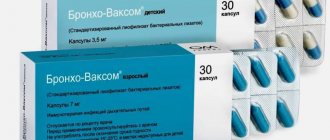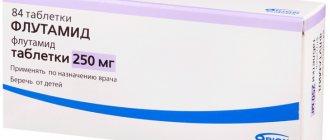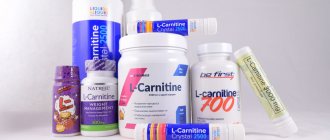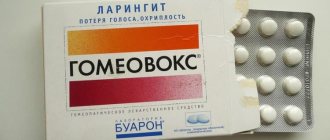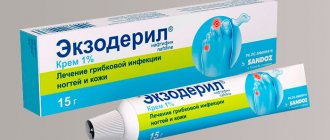Pharmacodynamics and pharmacokinetics
Mannitol - what is it?
Mannitol is an osmotic diuretic.
Pharmacodynamics
By increasing the osmotic pressure of plasma and enhancing filtration without tubular reabsorption , it promotes fluid retention in the tubules and an increase in the amount of urine. osmolarity increases, causing fluid to leak out of the tissues into the vascular bed. This leads to a pronounced diuretic effect, in which a large volume of osmotically free fluid, chlorine and sodium is excreted, without significant loss of potassium . Causes an increase in the amount of circulating blood.
Pharmacokinetics
In the liver, Mannitol undergoes minor metabolism to form glycogen . During excretion tubular reabsorption ; the process is controlled by glomerular filtration . The half-life is approximately 100 minutes. Excreted by the kidneys.
MANNITOL
Solution for infusion
transparent, colorless.
Excipients: sodium chloride – 9 g, water for injection – up to 1 l.
Theoretical osmolarity:
1132 mOsm/l.
100 ml – polymer containers (1) – bags (50) – cardboard boxes (for hospitals). 100 ml – polymer containers (1) – bags (75) – cardboard boxes (for hospitals). 250 ml – polymer containers (1) – bags (24) – cardboard boxes (for hospitals). 250 ml – polymer containers (1) – bags (36) – cardboard boxes (for hospitals).
500 ml – polymer containers (1) – bags (12) – cardboard boxes (for hospitals). 500 ml – polymer containers (1) – bags (18) – cardboard boxes (for hospitals). 1000 ml – polymer containers (1) – bags (6) – cardboard boxes (for hospitals).
1000 ml – polymer containers (1) – bags (9) – cardboard boxes (for hospitals).
Pregnancy and lactation
Adequate and strictly controlled studies in humans have not been conducted.
The use of mannitol during pregnancy and lactation is possible in cases where the expected benefit to the mother outweighs the possible risk to the fetus or infant.
Indications for use Mannitol
The drug has the following indications for use:
- oliguria in acute renal failure glomerular filtration );
- cerebral edema ; status epilepticus ; intracranial or intraocular hypertension , exacerbation of glaucoma ;
- acute liver failure;
- post-transfusion complications after transfusion of incompatible blood;
- poisoning with salicylates, barbiturates, lithium preparations, bromides; forced diuresis in case of poisoning with other substances;
- to prevent hemoglobinemia and hemolysis during resection of the prostate using the transurethral method, during bypass surgery on the pulmonary-cardiac system, during procedures involving extracorporeal circulation .
Mannitol what is it
Mannitol is a drug that has a pronounced diuretic effect. The composition also significantly increases the volume of blood circulating in the body. The main indications for its use are status epilepticus, high intracranial pressure, and renal failure.
The active component of the drug is the substance of the same name - mannitol. Among the auxiliary ingredients, the instructions note sodium chloride, sodium sulfacyl, flavacridine hydrochloride. Pharmaceutical companies produce the drug in the form of a solution for intravenous injection. It goes on sale in glass bottles of various sizes.
Instructions for use of Mannitol (Method and dosage)
Instructions for use of Mannitol indicate that this drug is administered intravenously (slow drip or jet method). The preventive dosage is 500 mg per kilogram of weight, the therapeutic dosage is 1.5 g per kilogram of weight. The highest daily dose is 140-180 g.
For interventions with extracorporeal circulation, 20-40 g of the drug is administered immediately before the intervention.
Patients with oliguria are first administered intravenously 200 mg per kg of body weight over 5 minutes. If within 3 hours after this there is no increase in diuresis to 30-45 ml/g, then administration of Mannitol should be abstained in the future.
Mannitol: instructions, synonyms, analogs, indications, contraindications, area of application and doses
MannitolDiuretics
| MannitolMannitol (S*PharmMannidex) |
01.042 (Osmotic diuretic) 01.082 (Cardioplegic drug)
21.015 (Plasma replacement drug)
Osmotic diuretic. Increasing plasma osmotic pressure and filtration without subsequent tubular reabsorption leads to water retention in the tubules and an increase in urine volume.
By increasing plasma osmolarity, it causes fluid to move from tissues (in particular, the eyeball, brain) into the vascular bed.
Causes a pronounced diuretic effect, in which there is the removal of a large amount of osmotically free water, as well as sodium, chlorine, without significant removal of potassium.
Causes an increase in blood volume.
Pharmacokinetics
The volume of distribution corresponds to the volume of extracellular fluid. Mannitol may undergo minor metabolism in the liver to form glycogen.
The excretion of mannitol is regulated by glomerular filtration without significant tubular reabsorption.
T1/2 is about 100 min. Excreted by the kidneys, with intravenous administration in a dose of 100 g, 80% is determined in the urine within 3 hours.
In case of renal failure, T1/2 may increase to 36 hours.
Dosage
Administer intravenously (slowly in a stream or drip). The prophylactic dose is 500 mg/kg body weight, the therapeutic dose is 1-1.5 g/kg. The daily dose should not exceed 140-180 g. For operations with extracorporeal circulation, a dose of 20-40 g is administered immediately before surgery.
Patients with oliguria should first administer a test dose of mannitol (200 mg/kg) intravenously over 3-5 minutes. If after this, within 2-3 hours there is no increase in the diuresis rate to 30-50 ml/g, then further administration of mannitol should be refrained.
Drug interactions
With the simultaneous use of mannitol with cardiac glycosides, their toxic effect associated with hypokalemia may increase.
Use during pregnancy and lactation
Adequate and strictly controlled studies in humans have not been conducted.
The use of mannitol during pregnancy and lactation is possible in cases where the expected benefit to the mother outweighs the possible risk to the fetus or infant.
Side effects
Metabolism: disturbances in water and electrolyte balance (increased blood volume, dilution hyponatremia, hyperkalemia) and their manifestations (muscle weakness, cramps, dry mouth, thirst, impaired consciousness).
Other: tachycardia, chest pain, thrombophlebitis, skin rash.
Indications
Brain swelling. Intracranial hypertension. Status epilepticus. Intraocular hypertension, acute attack of glaucoma.
Oliguria in acute renal failure. To determine the rate of glomerular filtration in acute oliguria.
Acute liver failure. Acute liver failure in patients with preserved renal filtration capacity and other conditions requiring increased diuresis.
Post-transfusion complications after administration of incompatible blood.
For the prevention of hemolysis and hemoglobinemia during transurethral resection of the prostate gland or when performing surgical procedures such as bypass surgery on the cardiopulmonary system, during operations with extracorporeal circulation.
Contraindications
Chronic renal failure, impaired filtration function of the kidneys, left ventricular failure (especially accompanied by pulmonary edema), hemorrhagic stroke, subarachnoid hemorrhage (except bleeding during craniotomy), severe forms of dehydration, hyponatremia, hypochloremia, hypokalemia, hypersensitivity to mannitol.
special instructions
Use with caution in patients with severe forms of chronic heart failure, hypovolemia, and impaired renal function.
If symptoms such as headache, vomiting, dizziness, and visual disturbances appear during the administration of mannitol, the administration should be stopped and the development of complications such as subdural and subarachnoid bleeding should be excluded.
When using mannitol, it is necessary to monitor blood pressure, diuresis, and the concentration of electrolytes in the blood serum (potassium, sodium).
Preparations containing MANNITOL
• MANNIT (MANNIT) solution d/inf 15%: fl. 200 ml or 400 ml• CUSTODIOL solution for perfusion: vial. 500 ml, packages 1 l, 2 l or 5 l• RHEOGLUMAN (RHEOGLUMAN) solution for inf. 10 g+5 g+900 mg/100 ml: vial. 200 ml 1 or 24 pcs., 400 ml 1 or 12 pcs. • RHEOGLUMAN (RHEOGLUMAN) solution for inf.
10 g+5 g+900 mg/100 ml: vial. 400 ml• MANNITOL solution d/inf 15%: fl. 200 ml or 400 ml• MANNIT (MANNIT) solution d/inf 15%: fl. 200 ml or 400 ml• MANNIT (MANNIT) solution d/inf 15%: fl. 200 ml or 400 ml
• MANNITOL solution for inf 15%: fl.
100 ml, 200 ml or 400 ml
Source: https://pharmacevtika.ru/annotation/Mannitol.html
special instructions
In the event of the development of symptoms such as vomiting, headache, visual disturbances, dizziness , the drug should be stopped and the development of subdural or subarachnoid hemorrhage .
When using the drug, you should monitor blood pressure, diuresis electrolyte levels in the blood.
Contraindications
According to the instructions for Mannitol, the use of this drug is contraindicated for:
- severe dehydration;
- Anuria due to acute necrosis of renal tubules;
- Impaired filtration function of the kidneys;
- Chronic heart failure;
- Subarachnoid hemorrhage (except for bleeding during craniotomy);
- Left ventricular failure (especially accompanied by pulmonary edema);
- Hemorrhagic stroke;
- Chronic renal failure;
- Hypokalemia;
- Hypochloremia;
- Hyponatremia;
- Hypersensitivity to mannitol or any auxiliary component.
Mannitol is prescribed, but with extreme caution and under constant supervision:
- During pregnancy;
- Breastfeeding women;
- Elderly people;
- With hypovolemia.
Pharmacological properties
Pharmacodynamics
Mannitol is an osmotic diuretic that promotes water retention in the renal tubules and increases urine volume. This action is based on an increase in the osmotic pressure of the blood plasma and filtration in the renal glomeruli, while subsequent tubular reabsorption is not observed (mannitol is reabsorbed to a small extent).
The therapeutic effect of Mannitol occurs primarily in the proximal tubule, although minor effects persist in the descending loop of the nephron and collecting ducts.
It does not penetrate through cellular and tissue barriers (including placental, blood-brain) and does not lead to an increase in the content of residual nitrogen in the blood. Due to an increase in blood plasma osmolarity, fluid moves from tissues (in particular, the brain, eyeball) into the vascular bed. Diuresis occurs with a moderate increase in natriuresis, while no significant effect on the excretion of potassium (K+) is noted.
The severity of the diuretic effect depends on the concentration of the substance. In patients with impaired filtration function of the kidneys, as well as azotemia in patients with liver cirrhosis and ascites, the use of the drug is ineffective.
Causes an increase in circulating blood volume.
Pharmacokinetics
Mannitol is distributed only in the extracellular sector, so its volume of distribution corresponds to the volume of extracellular fluid.
The substance may undergo minor metabolism in the liver, resulting in the formation of glycogen. The half-life of mannitol is approximately 100 minutes. Excretion is carried out by the kidneys, the process is regulated by glomerular filtration, with no significant participation of tubular reabsorption and secretion noted.
With intravenous administration of 100 g of Mannitol, 80% of the dose is determined in the urine within three hours. In renal failure, the half-life of the substance increases to approximately 36 hours.
Release form and composition
Dosage form - solution for infusion: transparent, colorless (in vials, containers or bottles of 100, 200, 250, 400, 500 or 1000 ml, in a cardboard box/box 1, 6, 9, 12, 15, 16, 18, 20, 24, 28, 36, 44, 50 or 75 pieces and instructions for use of Mannitol).
Composition of 1 ml solution:
- active substance: mannitol – 100 or 150 mg;
- excipients: sodium chloride – 9 mg, water for injection – up to 1 ml.
Theoretical osmolarity (100 or 150 mg/ml): 857 or 1132 mOsmol/L.
